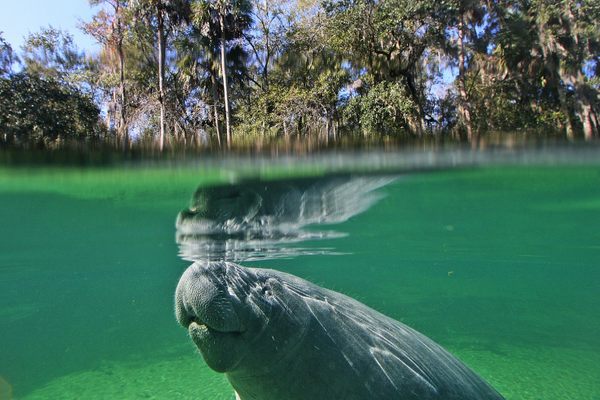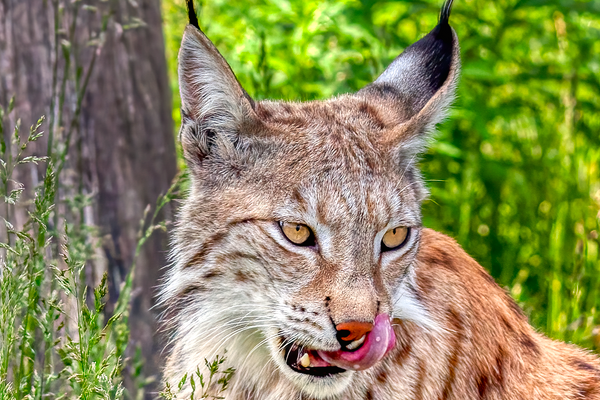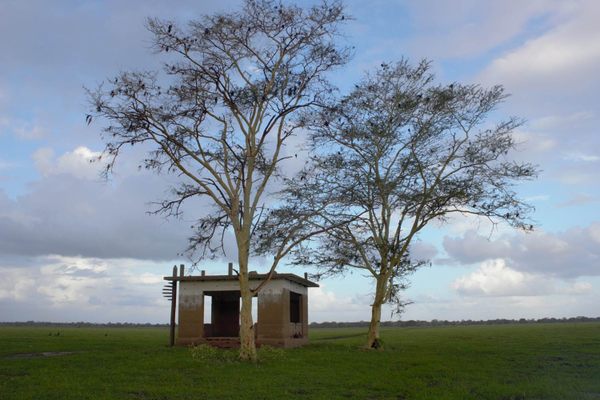In This Rainforest, Trafficked Animals Teach Each Other How To Be Wild
Animal specialists have to ignore crying babies, for their own good.

Two spider monkeys at ARCAS Peten. After months of learning how to be monkeys together, they’re almost ready for re-release. (Photo: Alejandro Morales)
Say you’re a Guatemalan yellow-naped parrot. After spending your first few days in the rainforest, your life is interrupted–like so many of your peers, you are nest-napped by a poacher. You’re about to be sold on the black market, but the government intervenes, rescuing you from captivity.
You’ve been saved from a life in a cage, or on a drug lord’s shoulder. But where do you go now?
Young animals separated from their families can’t just go back to the forest. They are unprepared for a wild environment, one that they might never have actually seen before. In many countries, a bird rescued from trafficking will spend the rest of its life in a zoo, or at a wildlife sanctuary. But in Guatemala, many animals end up at ARCAS Peten, a unique rehabilitation sanctuary deep in the rainforest. There, thanks to the dedicated human staff—and the support of their fellow rescue animals—parrots, monkeys, and other victims of the illegal pet trade have a shot at a normal life.
ARCAS—short for Asociación de Rescate y Conservación de la Vida Silvestre, or “Association for the Rescue and Conservation of Wildlife”—has sites in Guatemala City and Santa Rosa, but its largest, flagship facility is in Peten, a huge rainforest basin that stretches across the top of Guatemala. As soon as the association was up and running in 1991, the Guatemalan government began sending all the animals intercepted in the northern half of the country straight to Peten.
While there are many organizations worldwide that serve as animal rescue intake centers, sanctuaries, or rehabilitation facilities, Peten is the only one that handles all of these stages at once, says Dr. Alejandro Morales, the center’s assistant director. After years of trial and error, ARCAS has come up with a special set of protocols for rescuing, raising, and returning animals to the wild, based on subtle human intervention and natural socialization.
At a given time, the Peten site provides a home base for hundreds of individual animals at different stages of rehabilitation (the current count is 607). Some of these are loners—jaguars, anteaters, howler monkeys—but the particular demands of the black market mean that certain species, like parrots and spider monkeys, arrive in great numbers. Because of this, the center is in the unique position of being able to create whole animal societies for these species, halfway houses where, under the supervision of helpful humans, the animals teach each other how to live a wild life.
From the moment new animals arrive, ARCAS’s staff is thrust into an exercise in counterintuitive empathy, explains Morales. Because they’re often intercepted early in the illegal sale pipeline, most of ARCAS’s rescues arrive as babies, barely hatched birds, or tiny balls of fur. “For anyone that loves animals, your first reaction when you see a baby animal in need is to try to comfort it the way you would like to be comforted,” he says. “But sometimes, for them, comfort means being left alone.”

A raccoon gets used to the early stages of rehabilitation. (Photo: ARCAS)
Plus, that sort of attention might make things harder for them in the long run. “If they just grow among humans, they get way too humanized,” explains Morales. Wild jaguar cubs learn to hunt by spending 18 months watching their mothers. Parrots who pick up human speech patterns are ostracized from bird society.
This understanding sets the stage for the rest of the animal’s time at ARCAS. Following a brief quarantine period, your average rescue parrot at ARCAS is placed in a group of his peers. Fellow youngsters join adults who haven’t quite graduated yet to form an ad-hoc community, allowing the birds to “learn their natural tendencies, their natural behavior, their natural ways of feeding” from other parrots, says Morales.
Once the young parrot has passed his first test by successfully learning to fly, land, and perch, he is moved to an even bigger space with even more feathered friends. If the group socializes well together, they’re then moved to the largest enclosure of all, the size of an Olympic swimming pool and far from the camp. Here, they live immersed in the sights and sounds that will soon make up their whole world. They may even see or hear predators, so they can “learn how to be afraid,” says Morales.

Dr. Fernando Martinez, the director of ARCAS Peten, says farewell to a couple of scarlet macaws on last October’s release day. (Photo: Alejandro Morales)
By this point, humans have completely removed themselves from the equation–the animals don’t see or hear from them until they’re released. But, like worried parents sending their kids to college, they continue sneaking around in the background, making things easier for their increasingly independent charges. They forage for fruits and sprouts in the forest, and then hide them around the cages for the animals find on their own. They carefully inspect potential reintroduction spots, and find the one that is best prepared to support a new population. And they observe each individual, sometimes for up to 600 hours, to make sure it’s absolutely ready to do its darndest out in the wild.
The last stage, release, is a quiet but celebratory affair. Over the past few years, ARCAS has freed whole classes of spider monkeys, scarlet macaws, armadillos, raccoons, and toucans, to name just a few. The staff coaxes the animals back into small cages one last time, for transport to the carefully chosen release site. Then, in the middle of the rainforest, they throw open the doors—“the last doors they ever see,” Morales says.
Naturecultures is a weekly column that explores the changing relationships between humanity and wilder things. Have something you want covered (or uncovered)? Send tips to cara@atlasobscura.com.







Follow us on Twitter to get the latest on the world's hidden wonders.
Like us on Facebook to get the latest on the world's hidden wonders.
Follow us on Twitter Like us on Facebook